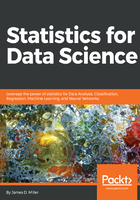
Key objectives of data science
As mentioned in Chapter 1, Transitioning from Data Developer to Data Scientist, the idea of how data science is defined is a matter of opinion.
I personally like the explanation that data science is a progression or, even better, an evolution of thought or steps, as shown in the following figure:

This data science evolution (depicted in the preceding figure) consists of a series of steps or phases that a data scientist tracks, comprising the following:
- Collecting data
- Processing data
- Exploring and visualizing data
- Analyzing (data) and/or applying machine learning (to data)
- Deciding (or planning) based on acquired insight
Although a progression or evolution implies a sequential journey, in practice, this is an extremely fluid process; each of the phases may inspire the data scientist to reverse and repeat one or more of the phases until they are satisfied. In other words, all or some phases of the process may be repeated until the data scientist determines that the desired outcome is reached.
For example, after a careful review of a generated visualization (during the Exploring and visualizing data phase), one may determine that additional processing of the data is required or that additional data needs to be collected before any reasonable analysis or learning could be of value.
Let's explain each of the phases of the data science evolution.